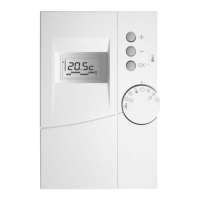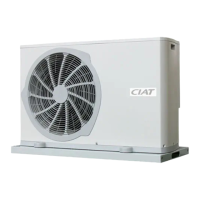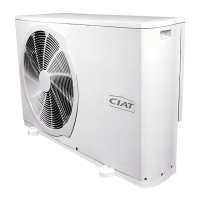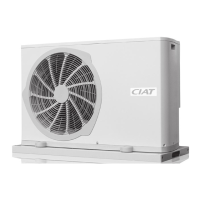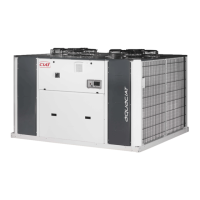Do you have a question about the CIAT VECTIOS POWER IPJ Series and is the answer not in the manual?
Essential safety guidelines for installation, maintenance, and operation personnel.
Information on R-410A refrigerant, safe handling, and leak detection procedures.
Explains the details found on the unit's nameplate and a legend for its components.
Instructions for safe transportation using a forklift, including dimensions and precautions.
Guidelines for lifting and moving units using crane equipment and appropriate slings.
Steps for unloading units from containers, including skid removal and forklift use.
Criteria for selecting the optimal installation site, considering environmental and performance factors.
Guidance on installing anti-vibration mounts to minimize noise and vibration transmission.
Details on installing optional pre-assembly roofcurbs for unit mounting on sloping roofs.
Instructions for handling, positioning, and securing roofcurbs on joists for unit installation.
Requirements for insulating and sealing roofcurbs to prevent water penetration and condensation.
Specifications for roofcurb dimensions and recommendations for air duct connections.
Steps for placing the unit onto the installed roofcurb and connecting electrical power.
Procedure for modifying the supply and return airflow direction on-site for various assemblies.
Detailed steps for changing the supply air direction, including panel removal and component placement.
Instructions for altering the return air direction, including damper adjustments and panel reassembly.
General rules and regulations for electrical connections, emphasizing safety and compliance.
Steps to verify the unit's power supply, including voltage stability and phase imbalance checks.
Guidance on selecting wire sizes and understanding the electrical cabinet's component layout.
Diagrams showing the location of electrical boxes and components within the unit.
Overview of the Vectic control system, including graphic terminal and TCO user terminal.
Diagrams illustrating the placement of various sensors within the unit's circuits.
Instructions for connecting external probes like ambient and air quality sensors.
Details on connecting NTC and RS485 probes for temperature and humidity measurements.
Procedure for installing and connecting the optional outdoor humidity probe.
Methods for installing and connecting CO2 probes, both ambient and duct-mounted.
Pre-commissioning and running checks for axial fans, including rotation direction and performance.
Pre-commissioning and running checks for EC plug-fans, focusing on rotation and flow control.
Procedure for aligning pulleys and setting belt tension for centrifugal fans.
Detailed steps for adjusting belt tension using the deflection test and recommended values.
Recommendations for calculating and designing air supply and return ducts, avoiding issues.
Guidelines for installing condensate drain pipes, including siphon requirements and slope.
Description of high and low pressure pressostats and their role in unit protection.
Details on magnetothermal switches, main door switch, and defrost control safety features.
Explanation of the differential pressostat for detecting clogged filters and alarm settings.
Explanation of safety features for managing condensation and evaporation pressure.
Information on anti-fire safety devices and optional smoke detector installations.
Safety features for refrigerant leak detection and anti-freeze protection for low temperatures.
Instructions for fitting fresh air and exhaust air damper hoods on site.
Procedure for installing the stop-drop device on the fresh air intake for moisture control.
Steps for installing the passive heat recovery module, including transport and electrical connection.
Guidance on accessing filters and condensate pan within the recovery module.
Types of air filters available, their specifications, and filter holder structure.
Instructions for installing the heat recovery coil, including valve kit and filling procedure.
Information on auxiliary electrical heaters, their power stages, and access for assembly.
Procedure for installing the stop-drop device within the indoor coil for moisture control.
Details on operating and installing the hot water coil, including safety features and connections.
Overview of gas burner characteristics, performance, safety features, and installation requirements.
Precautions for fuel handling, gas leaks, and burner operation safety.
Guidelines for gas burner maintenance, location, and delivery checks.
Instructions for connecting the condensate drain from the burner unit.
Procedure for connecting the outlet temperature probes to the unit.
Wiring instructions for connecting the burner control to the unit's electrical cabinet.
Details on flue connections, terminal types, and pressure drop calculations for gas burners.
Information on gas line connections, required components, and gas settings for different types.
Table of country-specific gas categories and procedures for converting between gas types.
Procedure for analyzing combustion, adjusting CO2 levels, and understanding burner operation.
Explanation of the burner's operating cycle and the function of safety thermostats.
Details on fault codes, air/gas premixing operation, and modulation PCB functions.
Information on the burner's integrated control board and its connection to the unit.
Details on low outdoor temperature protection and navigating the LCD interface panel.
List of fault codes, their causes, and remedies for the CPU-SMART PCB.
Description of the cooling recovery circuit components and their characteristics.
Procedure for adjusting the refrigerant charge in the cooling recovery circuit.
Explanation of the air zoning function for conditioning up to 4 different zones with airflow management.
Details on connecting zone terminals, zoning box, and servomotors for airflow control.
Essential checks before commissioning, including power supply, sensor connections, and crankcase heating.
Procedure for checking and adjusting the refrigerant charge, including leak verification.
Guidelines for verifying unit operation and recording key parameters for performance monitoring.
General advice for maintenance, personal safety, and handling of unit components and fluids.
Information on recommended oil types, volumes, and handling precautions for refrigeration units.
Guidelines for periodic refrigerant leak testing based on CO2 equivalent levels.
Schedule for weekly and monthly maintenance checks, including operational readings and visual inspections.
Instructions for accessing main components like the condensate drain pan for cleaning and maintenance.
Procedures for inspecting, cleaning, and replacing air filters in both the electrical cabinet and recovery module.
Instructions for cleaning air coils and replacing compressors, including safety precautions.
Guidance on replacing dryer filters and checking centrifugal fans and their motors.
Detailed steps for annual inspections of the gas burner, including electrodes, ducts, and safety checks.
Procedures for inspecting ignition, flue exhaust, venturi, exchanger, and gas pressure.
Steps for inspecting flame monitoring equipment, safety thermostats, and ionization current.
Analysis of high/low evaporation and condensation pressures and their potential causes and solutions.
Troubleshooting compressor start failures, intermittent motor noise, and noisy operation.
Procedures for safely shutting down units and recommendations for component disassembly and recycling.
Guidelines for recovering fluids and disposing of electrical and electronic equipment (WEEE).


